
The Integrated Taxonomic Information System (ITIS) is an American partnership of federal agencies designed to provide consistent and reliable information on the taxonomy of biological species. ITIS was originally formed in 1996 as an interagency group within the US federal government, involving several US federal agencies, and has now become an international body, with Canadian and Mexican government agencies participating. The database draws from a large community of taxonomic experts. Primary content staff are housed at the Smithsonian National Museum of Natural History and IT services are provided by a US Geological Survey facility in Denver. The primary focus of ITIS is North American species, but many biological groups exist worldwide and ITIS collaborates with other agencies to increase its global coverage.

The common vole is a European rodent.
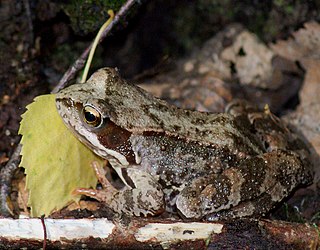
The moor frog is a slim, reddish-brown, semiaquatic amphibian native to Europe and Asia. Moor frogs are known for their ability to freeze solid and survive thawing. The frog makes use of various cryoprotectants i.e. antifreeze that decrease its internal freezing temperature. The species is distributed over a large range, covering a significant portion of Eurasia. Male moor frogs are known to turn blue temporarily during the height of mating season. This coloration is assumed to signal a mate's fitness. Moor frogs typically mate through multimale amplexus a form of polyandry.

The Orkney vole is a population of the common vole found in the Orkney Islands, off the northern coast of Scotland, as well as in the Channel Island of Guernsey. Orkney voles are about 10% larger than voles from other populations of the common vole. The common vole is absent from the rest of the British Isles.

Zhangixalus arvalis is a species of frog in the family Rhacophoridae. It is endemic to western and southwestern Taiwan and is present in agricultural areas of Chiayi, Yunlin, and Tainan. Common name farmland green treefrog has been coined for it.

Lachesillidae is a family of Psocodea belonging to the suborder Psocomorpha. Members of the family are characterized by a rounded, free areola postica in their wings. Males have diverse sclerotized genitalic structures. The family includes more than 400 species, most of them in the genus Lachesilla.
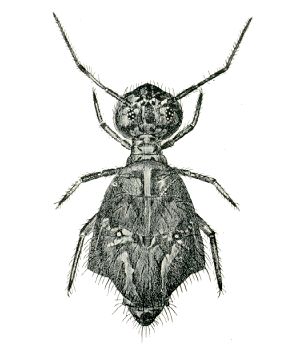
Sminthuridae, not to be confounded with: Sminthurididae, is a family of springtails of the order Symphypleona. Sminthurids are commonly referred to as globular springtails.
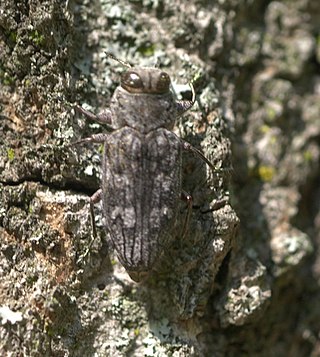
Chrysobothris is a genus of metallic wood-boring beetles in the family Buprestidae. There are at least 690 described species in Chrysobothris.
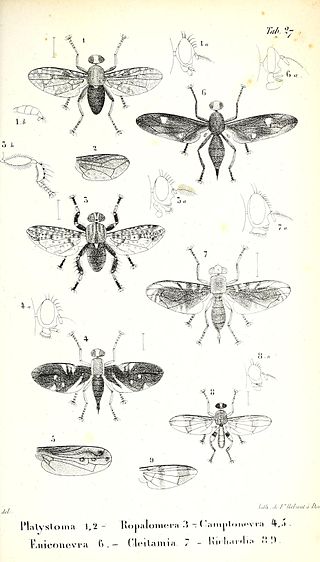
The Ropalomeridae are a family of acalyptrate flies.
Tula orthohantavirus, formerly Tula virus (TULV), is a single-stranded, negative-sense RNA virus species of orthohantavirus first isolated from a European common vole found in Central Russia and primarily carried by rodents. It causes Hantavirus hemorrhagic fever with renal syndrome. The Microtus species are also found in North America, Europe, Scandinavia, Slovenia, Asia, and Western Russia. Human cases of Tula orthohantavirus have also been reported in Switzerland and Germany.

iNaturalist is an American 501(c)(3) nonprofit social network of naturalists, citizen scientists, and biologists built on the concept of mapping and sharing observations of biodiversity across the globe. iNaturalist may be accessed via its website or from its mobile applications. iNaturalist includes an automated species identification tool, and users further assist each other in identifying organisms from photographs and even sound recordings. As of 9 July 2024, iNaturalist users had contributed approximately 197,660,888 observations of plants, animals, fungi, and other organisms worldwide, and 290,007 users were active in the previous 30 days.
Bourletiella viridescens is a species of springtail. Its common name is "Garden Springtail"
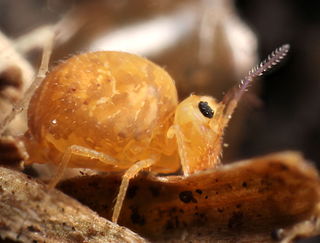
Bourletiella hortensis is a springtail of the family Bourletiellidae. The species common name is garden springtail. It feeds on moss and fungi.
Annaphila arvalis is a species of moth in the family Noctuidae. It was described by Henry Edwards in 1875 and is found in North America, where it has been recorded from foothill canyons and riparian habitats in south-eastern British Columbia, eastern Washington, north-central Oregon, south to southern California.
Bourletiella juanitae is a species of globular springtails, arthropods in the family Bourletiellidae.
Bourletiella rustica is a species of globular springtails in the family Bourletiellidae.
Animal Ethics is a nonprofit organization formed to promote discussion and debate around issues in animal ethics and to provide information and resources for animal advocates. They also do outreach work in several countries on the issue of speciesism. Their aim is to create a world where moral consideration is extended to all sentient beings. The organization's website covers topics such as speciesism, sentience, veganism and wild animal suffering and has content translated into several languages.
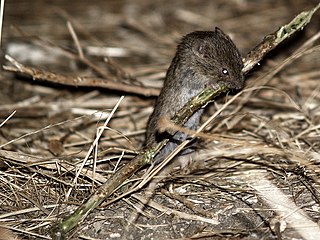
The 2007 vole plague originated in early summer 2006 in the province of Palencia, located in the autonomous community of Castile and León, Spain. By the summer of 2007, rodent populations had severely devastated crops in the plateau fields. Following a summer marked by significant agricultural losses, the density of voles decreased by September 2007, leading to the institutional declaration that the plague was over. However, vole populations remained abundant in the months that followed. It was only the winter frosts and low temperatures in November and December that reduced their numbers to normal levels.













